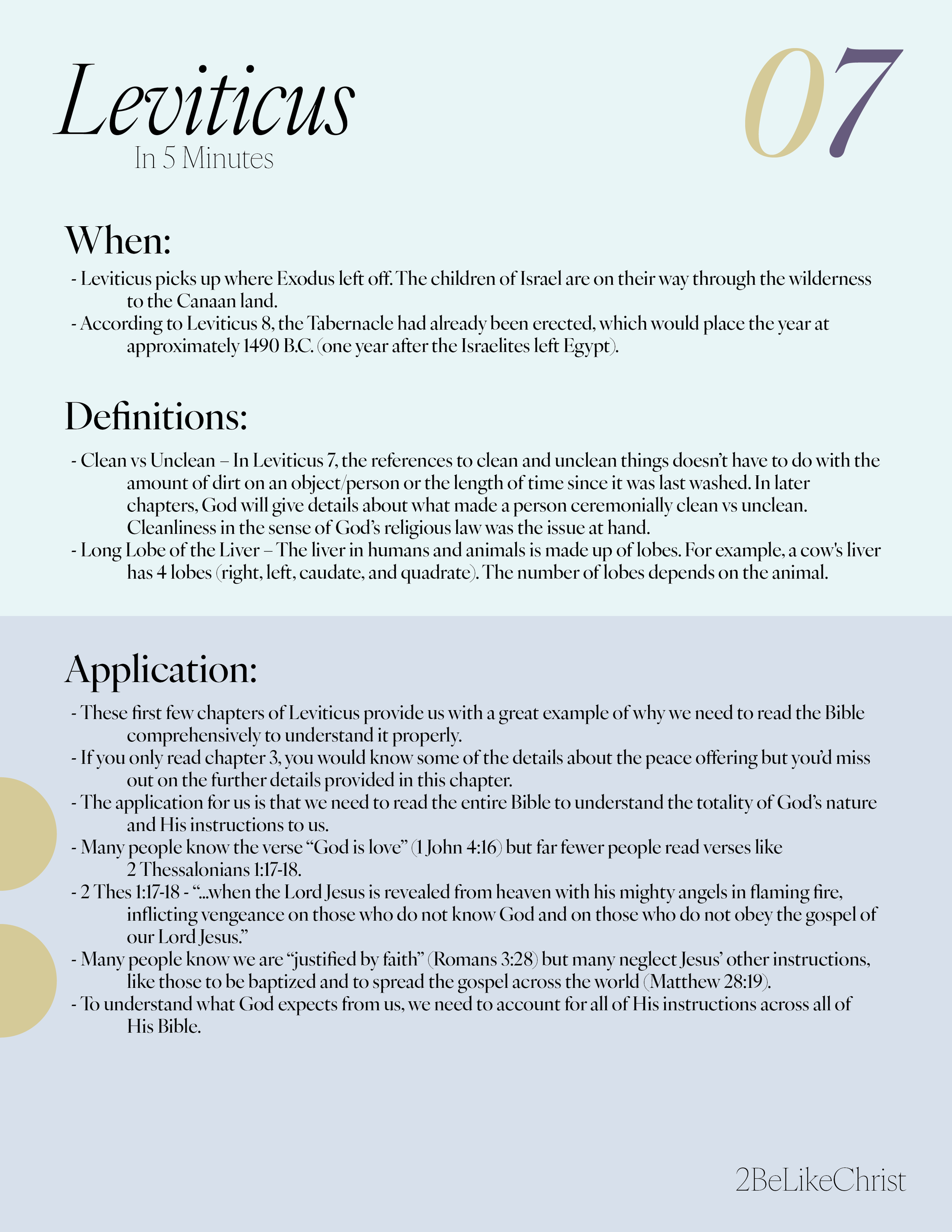Leviticus 7 Summary: A Short Breakdown in 5 Minutes
Leviticus 7 Summary - A Quick Overview
WHEN:
Leviticus picks up where Exodus left off. The children of Israel are on their way through the wilderness to the Canaan land.
According to Leviticus 8, the Tabernacle had already been erected, which would place the year at approximately 1490 B.C. (one year after the Israelites left Egypt).
DEFINITIONS:
Clean vs Unclean – In Leviticus 7, the references to clean and unclean things doesn’t have to do with the amount of dirt on an object/person or the length of time since it was last washed. In later chapters, God will give details about what made a person ceremonially clean vs unclean. Cleanliness in the sense of God’s religious law was the issue at hand.
Long Lobe of the Liver – The liver in humans and animals is made up of lobes. For example, a cow's liver has 4 lobes (right, left, caudate, and quadrate). The number of lobes depends on the animal.
TABERNACLE DIAGRAM
OUTLINE:
INSTRUCTIONS FOR GUILT OFFERINGS (7:1-6):
The blood of an animal offered as a guilt offering was to be thrown against the side of the bronze altar.
Its fat was to be removed and burned on the altar.
Part of the animal could be kept and eaten by the priests, but it was only to be eaten in a holy place.
THE PORTION FOR THE PRIESTS (7:7-10):
The priest who offered the guilt offering received a portion of the offering.
The priest who offered a burnt offering was allowed to keep the skin of the animal.
A portion of the cooked bread offered as a grain offering was kept by the priest who offered it.
If flour was brought for a grain offering, the priest’s portions was divided amongst all of Aaron’s sons.
INSTRUCTIONS FOR PEACE OFFERINGS (7:11-21):
If a peace offering was brought for thanksgiving, the offeror was to bring the animal to be sacrificed along with unleavened loaves mixed with oil, unleavened wafers smeared with oil, and loaves of fine flour mixed with oil.
Part of the animal used for the peace offering was to be eaten by the one who brought the sacrifice. He was to eat it the same day and not leave any leftover in the morning.
If the peace offering was for a vow or brought as a freewill offering, the meat of the animal was to be eaten on the day of the sacrifice, the next day, but none was to be left over for the third day.
The meat of the peace offering wasn’t to touch anything that was ceremonially unclean, and no unclean person was to eat of the meat.
PROHIBITION ON EATING FAT AND BLOOD (7:22-27):
The Israelites were prohibited from eating the fat of oxen, sheep, and goats.
They were also forbidden to eat blood. Any person found eating blood was to be “cut off from his people.”
ADDITIONAL INSTRUCTIONS FOR THE PEACE OFFERING (7:28-38):
An individual offering a peace offering was to bring their animal to the Tabernacle. The breast, the thigh, and the fat of the animal were to be separated.
The fat was to be burned on the altar.
The breast was to be waved as a wave offering before the Lord and then given to the priests.
The right thigh was given to whichever priest sacrificed the animal’s blood.
APPLICATION:
These first few chapters of Leviticus provide us with a great example of why we need to read the Bible comprehensively to understand it properly.
If you only read chapter 3, you would know some of the details about the peace offering but you’d miss out on the further details provided in this chapter.
The application for us is that we need to read the entire Bible to understand the totality of God’s nature and His instructions to us.
Many people know the verse “God is love” (1 John 4:16) but far fewer people read verses like 2 Thessalonians 1:17-18.
2 Thes 1:17-18 - “…when the Lord Jesus is revealed from heaven with his mighty angels in flaming fire, inflicting vengeance on those who do not know God and on those who do not obey the gospel of our Lord Jesus.”
Many people know we are “justified by faith” (Romans 3:28) but many neglect Jesus’ other instructions, like those to be baptized and to spread the gospel across the world (Matthew 28:19).
To understand what God expects from us, we need to account for all of His instructions across all of His Bible.


